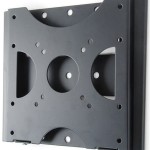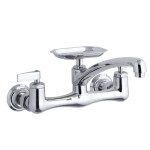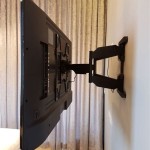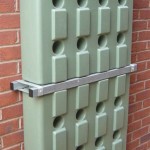Double Sided Tape For Wall Mounting: A Comprehensive Guide
Double-sided tape has become a ubiquitous adhesive solution, offering a versatile and often damage-free alternative to traditional methods like nails, screws, and glues. Its application in wall mounting, in particular, has gained significant traction due to its ease of use, minimal surface disruption, and suitability for a wide range of materials. This article provides a comprehensive overview of double-sided tape for wall mounting, exploring its types, strengths, applications, and best practices to ensure a secure and long-lasting hold.
The concept of double-sided tape is inherently simple: an adhesive coating applied to both sides of a carrier material. This allows for the bonding of two surfaces together without the need for visible fasteners. The carrier material can vary significantly, influencing the tape's strength, flexibility, and suitability for different applications. Common carrier materials include paper, foam, film (such as PET or acrylic), and cloth. Each type possesses distinct characteristics that make it more appropriate for specific wall mounting tasks.
The adhesive itself is also a critical factor in determining the tape's overall performance. Acrylic adhesives are known for their strong initial tack and excellent long-term bonding strength. Rubber-based adhesives offer high initial adhesion and good conformability to irregular surfaces. Silicone adhesives provide excellent temperature resistance and chemical resistance, but may not offer the same level of initial tack as other types. Understanding the properties of both the carrier material and the adhesive is crucial for selecting the right double-sided tape for a given wall mounting project.
Understanding Different Types of Double-Sided Tape
The market offers a plethora of double-sided tape options, each designed with specific applications in mind. Differentiating between these types is essential for making an informed choice that aligns with the weight, surface material, and environmental conditions of the mounting project. Ignoring these nuances can lead to failure of the adhesive bond and potential damage to the mounted item or the wall surface.
Foam Tape: Foam tapes are characterized by their thick, cushioning carrier material, typically made of polyethylene or acrylic foam. This foam core offers excellent conformability to uneven surfaces, filling gaps and distributing stress evenly across the bond line. Foam tapes are particularly well-suited for mounting items on slightly textured walls or for applications where vibration dampening is required. They are generally available in various thicknesses and densities, with higher densities providing greater strength and support for heavier objects. However, foam tapes can be more susceptible to moisture absorption than other types, so they may not be ideal for humid environments.
Film Tape: Film tapes utilize a thin film carrier, typically made of polyester (PET), polypropylene (PP), or acrylic. This thin profile allows for a close-fitting bond and makes them virtually invisible when applied between two surfaces. Film tapes offer excellent dimensional stability and resistance to chemicals and solvents. They are often used for applications requiring high precision and a clean aesthetic, such as mounting decorative trims, nameplates, or lightweight signage. Due to their limited thickness, film tapes are generally best suited for smooth, even surfaces and lighter objects.
Cloth Tape: Cloth tapes feature a woven fabric carrier, providing excellent tensile strength and tear resistance. This makes them suitable for applications requiring a durable and flexible bond. Cloth tapes are often used for mounting temporary fixtures, securing cables, or reinforcing joints. While they offer good adhesion to a variety of surfaces, their texture can be visible through transparent materials, making them less desirable for aesthetic applications. They also tend to be more expensive than other types of double-sided tape.
Acrylic Gel Tape: Acrylic gel tapes represent a high-performance category of double-sided adhesives. These tapes utilize a thick, viscoelastic acrylic gel layer that offers exceptional bonding strength, conformability, and resistance to environmental factors. Acrylic gel tapes are capable of supporting significant weight and can withstand extreme temperatures and UV exposure. They are often used in demanding applications such as automotive trim attachment, structural bonding, and heavy-duty signage mounting. While acrylic gel tapes offer superior performance, they are generally more expensive and may require specific surface preparation techniques for optimal adhesion.
Removable Tape: Removable double-sided tapes are designed for temporary mounting applications where easy removal is desired without leaving residue or damaging the surface. These tapes typically utilize a low-tack adhesive and a carrier material that is easily peeled away. Removable tapes are ideal for hanging posters, decorations, or temporary signage in rental properties or offices. However, their lower adhesive strength limits their suitability for heavier objects or permanent installations. It is crucial to test the tape on a small, inconspicuous area of the wall before applying it to the entire surface to ensure it does not damage the paint or wallpaper upon removal.
Factors Influencing Adhesive Strength and Longevity
The success of any wall mounting project using double-sided tape hinges on the strength and durability of the adhesive bond. Several factors can significantly influence the tape's performance, including surface preparation, weight distribution, environmental conditions, and the inherent properties of the tape itself. A thorough understanding of these factors is essential for maximizing the tape's holding power and ensuring a long-lasting, reliable bond.
Surface Preparation: Proper surface preparation is paramount for achieving optimal adhesion. The surface must be clean, dry, and free from dust, grease, oil, and other contaminants. These contaminants can interfere with the adhesive's ability to make intimate contact with the surface, reducing its bonding strength. Cleaning the surface with isopropyl alcohol or a specialized adhesive promoter can effectively remove contaminants and improve adhesion. It's also important to ensure that the surface is smooth and free from loose particles or flakes. For porous surfaces like drywall, applying a primer or sealant can create a more uniform and stable surface for the tape to adhere to.
Weight Distribution: Evenly distributing the weight of the mounted object across the tape's surface is crucial for preventing stress concentrations that can lead to bond failure. Using multiple strips of tape strategically positioned to support the object's weight is more effective than relying on a single, long strip. For heavier objects, it may be necessary to use a larger surface area of tape or to reinforce the bond with mechanical fasteners. Consider the object's center of gravity and ensure that the tape is positioned to adequately support the weight along that axis.
Environmental Conditions: Environmental factors such as temperature, humidity, and UV exposure can significantly impact the adhesive's performance. Extreme temperatures can weaken the adhesive bond, while high humidity can cause the tape to lose its tackiness over time. Prolonged exposure to UV radiation can degrade the adhesive and the carrier material, leading to bond failure. When mounting objects in outdoor environments or areas with fluctuating temperatures or humidity levels, it's essential to select a tape that is specifically designed to withstand these conditions. Acrylic gel tapes often offer superior resistance to environmental factors compared to other types of double-sided tape.
Tape Selection: Choosing the right type of double-sided tape for the specific application is critical for ensuring a strong and durable bond. Consider the weight of the object, the surface material, and the environmental conditions when selecting the tape. Refer to the manufacturer's specifications for the tape's load-bearing capacity and recommended application guidelines. It's always advisable to choose a tape with a higher load-bearing capacity than what is strictly required to provide a safety margin and ensure long-term reliability.
Best Practices for Wall Mounting with Double-Sided Tape
Adhering to best practices during the wall mounting process can significantly enhance the success and longevity of the adhesive bond. From selecting the appropriate tape to applying it correctly and allowing it to cure properly, each step plays a crucial role in ensuring a secure and reliable installation. Skipping steps or cutting corners can compromise the bond's integrity and lead to potential failures.
Surface Testing: Before applying double-sided tape to a large area, it is crucial to test a small, inconspicuous section of the wall to ensure compatibility and prevent damage. Apply a short strip of tape to the test area and leave it in place for 24-48 hours. After this period, carefully remove the tape and inspect the wall surface for any signs of damage, such as paint peeling or residue left behind by the adhesive. If the tape removes cleanly without damaging the surface, it is likely safe to use on the larger area. This simple test can save considerable time and effort in the long run by preventing costly repairs.
Application Technique: Proper application technique is essential for maximizing the tape's adhesive strength. Start by peeling back a small section of the release liner and carefully positioning the tape on the wall. Slowly peel back the remaining liner while applying firm, even pressure to the tape. This ensures that the adhesive makes full contact with the surface and minimizes air bubbles. Use a roller or squeegee to apply additional pressure and ensure a uniform bond. After applying the tape to the wall, repeat the process on the object to be mounted. Align the object carefully and press it firmly against the wall, maintaining consistent pressure for several minutes to allow the adhesive to bond properly.
Curing Time: Double-sided tape requires a certain amount of curing time to achieve its full bonding strength. The curing time varies depending on the type of tape and the environmental conditions, but it is generally recommended to allow at least 24-72 hours for the adhesive to fully cure. During this period, avoid applying any stress or weight to the mounted object. Keep the area around the mounted object free from dust and moisture to ensure a clean and stable environment for the curing process. Refer to the manufacturer's specifications for the recommended curing time for the specific type of tape being used.
Weight Limits: Always adhere to the manufacturer's recommended weight limits for the double-sided tape being used. Exceeding these limits can overload the adhesive bond and lead to failure. If mounting a heavier object, consider using multiple strips of tape to distribute the weight more evenly or reinforce the bond with mechanical fasteners. When in doubt, it is always better to err on the side of caution and choose a tape with a higher load-bearing capacity than what is strictly required. Regular inspections of the mounted object are recommended, especially for valuable or fragile items. Check for any signs of loosening or slippage and take corrective action immediately to prevent accidents.

Double Sided Tape Heavy Duty Stick Mounting Adhesive 1 Rolls Total 9 84ft Clear Two Wall Strips Removable Poster For

Strong Nano Double Sided Tape Heavy Duty Mounting Clear Removable Sticky Adhesive Strips No Damage Wall Waterproof Reusable Thick Gel Grip Washable

Scotch Mount Indoor Double Sided Mounting Tape 3m United States

Jeexi Double Sided Nano Tape Heavy Duty 16 4ft 10 Mini Tapes Zero Damage Multipurpose Removable Mounting Gel Strip Adhesive Grip Strong Sticky

Scotch Heavy Duty Mounting Tape Double Sided Wall White Plastic 1 Pack

Scotch Mount Extreme Double Sided Mounting Tape 1 X 60 Roll Black 414p

Greenfix Heavy Duty Double Sided Tape Strong Adhesive Mounting Waterproof Removable Nano Clear Wall

Heavy Duty 4 Yard Strong Double Side Stick Foam Mounting Tape Wall Mount Picture

Getuscart Double Sided Tape 0 39in X 16 5ft Mounting Heavy Duty Removeable Pe Foam Strips Strong Adhesive Waterproof Free Damage For Paint Wall Picture Hanging Poster

Scotch Double Sided Foam Mounting Tape 1 2 X 150 Roll








